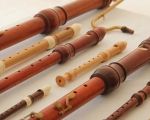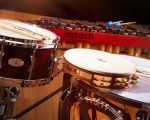How to Choose the Right Drum Kit for Metal Drummers
As a metal drummer, your drum kit is your instrument of expression, the foundation of your performance, and the tool that helps you deliver those fast, aggressive, and powerful beats that define the genre. Over the years, I’ve experimented with various setups and spent hours refining the perfect kit for metal drumming. Choosing the right drum kit isn’t as simple as picking the most expensive or the most flashy one—it's about finding a setup that matches your playing style, your budget, and the sound you want to create. In this guide, I’ll walk you through the key factors to consider when selecting a drum kit specifically designed for metal drumming.
1. Understand the Key Components of a Metal Drum Kit
Before diving into specifics, it’s important to understand what makes a drum kit suitable for metal drumming. Metal drummers require equipment that can handle fast, aggressive playing with precision. You’ll need a kit that is durable, responsive, and capable of producing powerful sounds, especially for blast beats and double bass drumming. The essential components of a metal drum kit are:
- Drum Shells: Metal drummers often prefer drums with a deep, resonant sound that can stand up to high-speed hits.
- Cymbals: High-pitched, aggressive cymbals like crash cymbals, rides, and splashes are a must for cutting through heavy guitar riffs.
- Hardware: Metal drummers need durable, sturdy hardware that can withstand intense playing and fast movements, especially for double bass pedals.
2. Choosing the Right Drum Shells for Metal
The material and size of your drum shells will play a huge role in shaping your drum sound. For metal, the key is to choose shells that produce a sharp, punchy tone with plenty of volume. Here are some tips for selecting drum shells:
- Wood vs. Metal Shells: Metal drummers often opt for drums made from maple, birch, or even metal such as steel or aluminum. Maple drums offer a warm sound but lack the punch required for fast and aggressive playing. Birch drums, on the other hand, are brighter and provide excellent projection, making them ideal for metal music.
- Drum Depth: Deeper drums (especially for the toms) help produce a fuller sound. For the bass drum, look for deeper shells to give it the low-end punch and clarity required for fast double bass drumming.
- Snare Drum: A metal snare drum with a solid, crisp sound is essential. Consider a snare drum with a higher-pitched tone that can slice through the rest of the kit during high-speed fills and blast beats.
3. Selecting Cymbals for Metal Drumming
Cymbals are crucial in metal for providing the cutting-edge sound that complements fast beats and the overall heaviness of the genre. Here’s what to consider when selecting cymbals:
- Crash Cymbals: A bright and sharp crash cymbal will give you the necessary accent for fast hits and transitions in metal music. Look for cymbals with a fast decay and high-pitched tones to ensure they don’t get lost in the mix.
- Ride Cymbals: A ride cymbal in metal needs to have a clear bell sound and sustain to match the fast tempos of the genre. Go for heavier cymbals that can withstand intense use without losing their tone.
- Hi-Hats: For metal, the hi-hats should be tight, quick, and aggressive. A pair of heavy-duty hi-hats will produce the sharp sound you need when playing complex rhythms.
- China Cymbals: For added emphasis on accentuating faster and heavier sections of songs, consider a china cymbal for its trashy, cutting sound.
4. Double Bass Pedal and Hardware
No metal drum kit is complete without a high-quality double bass pedal, especially if you’re into fast beats and blast beats. I’ve found that investing in a smooth, reliable double bass pedal makes all the difference in achieving tight, fast-paced rhythms. Look for pedals that are easy to adjust, durable, and responsive. Some key features to consider are:
- Pedal Action: Make sure the pedal has smooth action and is responsive to your movements. Chain-drive pedals are common, but you can also consider direct-drive pedals for faster response times.
- Stability: Heavy-duty pedals that are built to withstand fast play will make a big difference. Ensure the pedals are stable, even under intense pressure, to avoid slipping during performances.
- Adjustability: You’ll want a pedal that is fully adjustable to fit your style. Adjusting the tension can change the responsiveness and how quickly you can perform certain techniques.
5. Drum Kit Setup and Customization
The way you set up your drum kit can also impact how well it supports your playing style. For metal, you’ll want to make sure everything is within easy reach and positioned for fast, comfortable playing. The bass drum should be front and center, while the toms and cymbals should be positioned for easy access without straining your arms or wrists. I recommend customizing your setup to match the intensity of metal drumming—having your hardware and pedals positioned at an ergonomic height can make all the difference during long practice sessions or shows.
6. Budget and Brand Selection
When choosing your drum kit, budget plays a significant role. High-end kits from brands like DW, Pearl, and Tama are great for metal, but they come with a hefty price tag. If you’re just starting out, there are many affordable options from brands like Mapex and Gretsch that still provide solid performance for metal drumming. From my own experience, I suggest finding a balance between quality and budget—don’t settle for a kit that’s too cheap, but also don’t overpay for features you don’t need right away.
Conclusion: Building the Perfect Metal Drum Kit
Choosing the right drum kit for metal drumming is a personal and detailed process. By considering the type of drum shells, the quality of your cymbals, investing in a top-notch double bass pedal, and finding the right setup for your playing style, you’ll be able to achieve the perfect sound for the high-energy demands of metal music. It may take some trial and error, but once you’ve built your ideal kit, the result is worth the effort. I’ve enjoyed the process of refining my kit over the years, and I hope these tips help you find the drum kit that takes your metal drumming to the next level. For more expert advice and equipment recommendations, visit Beat Trigger today.








